The NVIDIA GeForce GTX Titan X Review
by Ryan Smith on March 17, 2015 3:00 PM ESTOverclocking
Finally, no review of a GTX Titan card would be complete without a look at overclocking performance.
From a design standpoint, GTX Titan X already ships close to its power limits. NVIDIA’s 250W TDP can only be raised another 10% – to 275W – meaning that in TDP limited scenarios there’s not much headroom to play with. On the other hand with the stock voltage being so low, in clockspeed limited scenarios there’s a lot of room for pushing the performance envelope through overvolting. And neither of these options addresses the most potent aspect of overclocking, which is pushing the entirely clockspeed curve higher at the same voltages by increasing the clockspeed offsets.
GTX 980 ended up being a very capable overclocker, and as we’ll see it’s much the same story for the GTX Titan X.
| GeForce GTX Titan X Overclocking | ||||
| Stock | Overclocked | |||
| Core Clock | 1002MHz | 1202MHz | ||
| Boost Clock | 1076Mhz | 1276MHz | ||
| Max Boost Clock | 1215MHz | 1452MHz | ||
| Memory Clock | 7GHz | 7.8GHz | ||
| Max Voltage | 1.162v | 1.218v | ||
Even when packing 8B transistors into a 601mm2, the GM200 GPU backing the GTX Titan X continues to offer the same kind of excellent overclocking headroom that we’ve come to see from the other Maxwell GPUs. Overall we have been able to increase our GPU clockspeed by 200MHz (20%) and the memory clockspeed by 800MHz (11%). At its peak this leads to the GTX Titan X pushing a maximum boost clock of 1.45GHz, and while TDP restrictions mean it can’t sustain this under most workloads, it’s still an impressive outcome for overclocking such a large GPU.
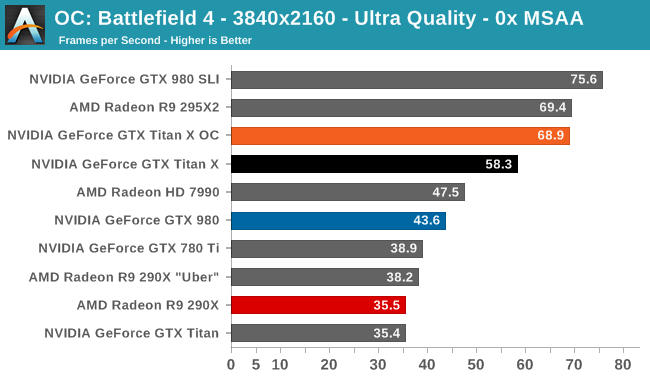
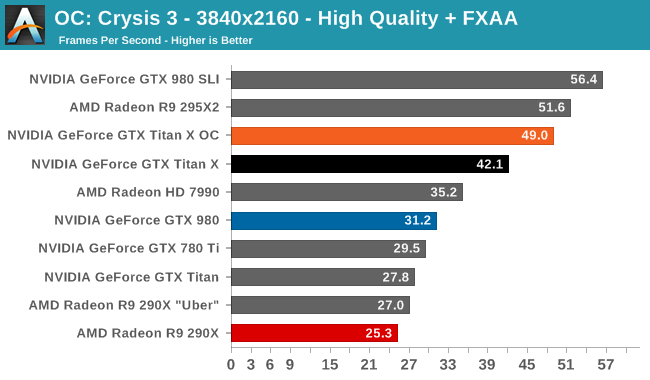
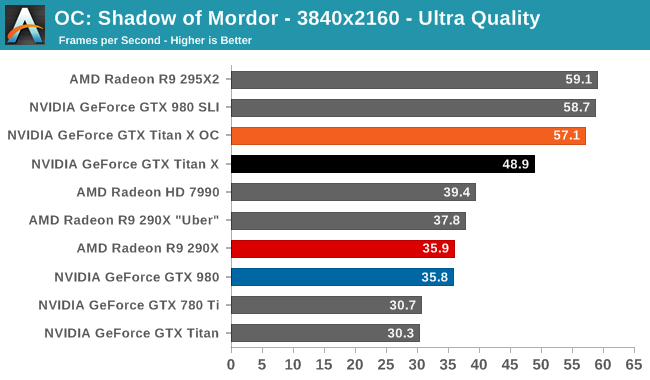
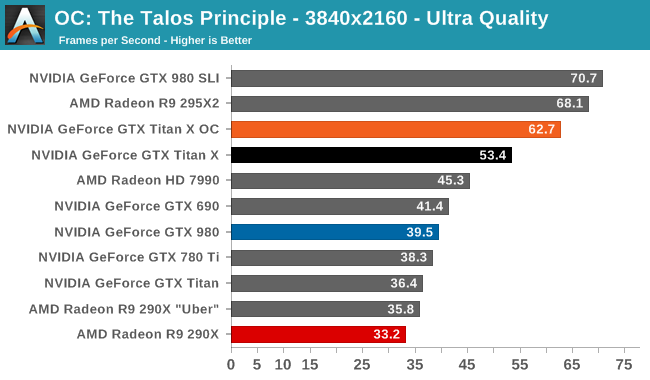
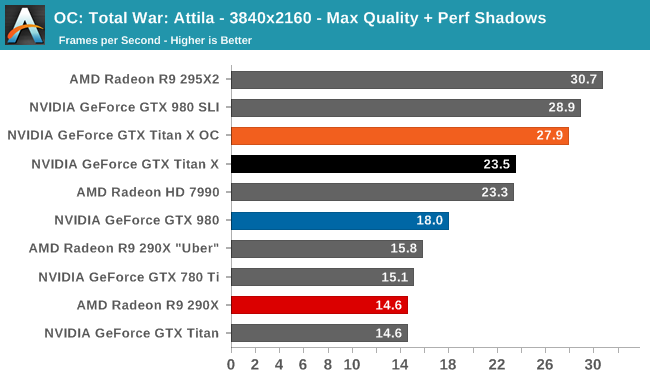
The performance gains from this overclock are a very consistent 16-19% across all 5 of our sample games at 4K, indicating that we're almost entirely GPU-bound as opposed to memory-bound. Though not quite enough to push the GTX Titan X above 60fps in Shadow of Mordor or Crysis 3, this puts it even closer than the GTX Titan X was at stock. Meanwhile we do crack 60fps on Battlefield 4 and The Talos Principle.
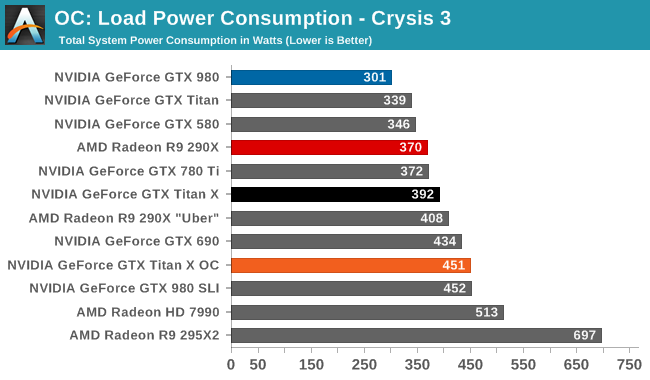
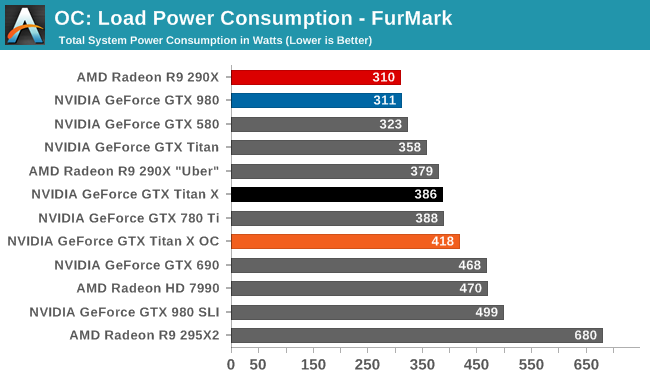
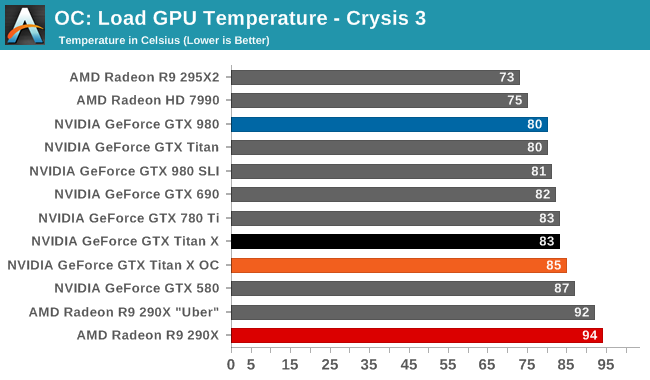
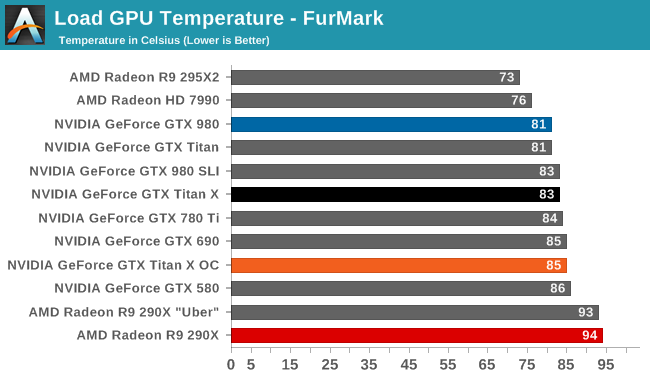


The tradeoff for this overclock is of course power and noise, both of which see significant increases. In fact the jump in power consumption with Crysis is a bit unexpected – further research shows that the GTX Titan X shifts from being temperature limited to TDP limited as a result of our overclocking efforts – while FurMark is in-line with the 25W increase in TDP. The 55dB noise levels that result, though not extreme, also mean that GTX Titan X is drifting farther away from being a quiet card. Ultimately it’s a pretty straightforward tradeoff for a further 16%+ increase in performance, but a tradeoff nonetheless.










276 Comments
View All Comments
chizow - Tuesday, March 17, 2015 - link
AMD fanboys went apeshit when AT used non-ref cooled GTX 460s that showed those cards in better light than the reference coolers, AMD fanboys need to pick a story and stick to it tbh.evolucion8 - Tuesday, March 17, 2015 - link
Ahh, we can't never miss your daily dose of AMD bashing under any GPU article, thanks for the fun.shing3232 - Tuesday, March 17, 2015 - link
Yep, it is quite entertaining.Kutark - Tuesday, March 17, 2015 - link
Entertaining but still accurate. Fanbois are fanbois, they're stupid regardless of what side of the isle they're on.chizow - Tuesday, March 17, 2015 - link
Like I said, happy to keep the AMD fanboys honest. as I did again here.Stuka87 - Tuesday, March 17, 2015 - link
That had nothing to do with non-ref cooled 460's. It was using FTW versions, which were heavily overclocked vs stock clocked AMD cards. It had nothing to do with what cooler was on them. Just the overclocked being portrayed as though they were standard edition cards. The article was later changed as I recall to state that they were overclocked cards and not stock 460s.chizow - Wednesday, March 18, 2015 - link
Its the same difference, the AMD cards are no more "stock" with custom coolers than those FTW editions. AMD baked an overclock into their boost that they weren't able to sustain without extravagant cooling. And when I mean extravagant cooling, I am talking about the Cadillac Aluminum Boat we used to be like "Oh wow, maybe one day I will fork out $60 for that massive Arctic Cooling cooler".So yeah, now you get "stock clocked, stock cooled reference cards", if you want AMD to show better in benchmarks, have them design either 1) better cooling or 2) less power hungry cards.
chizow - Tuesday, March 17, 2015 - link
@Ryan, we can't revisit all the nerdrage and angst from AMD fanboys over EVGA sending you non-reference cooled GeForce cards because they were too good over reference? Funny what happens when the shoe is on the other foot!My solution: AMD should design cards that are capable of comfortably fitting within a 250W TDP and cooler designed to dissipate that much heat, and not have to resort to a cooler that looks like an Autobot. I'm not kidding, briefly owned a Sapphire Tri-X 290X and the thing doubles as its own appliance.
Stuka87 - Tuesday, March 17, 2015 - link
Stop stating that it was because of the cooler. As I mentioned above, FTW cards are heavily overclocked and should not be portrayed as standard edition cards.MrSpadge - Tuesday, March 17, 2015 - link
Go back and read that article. The factory-OC was clearly stated.